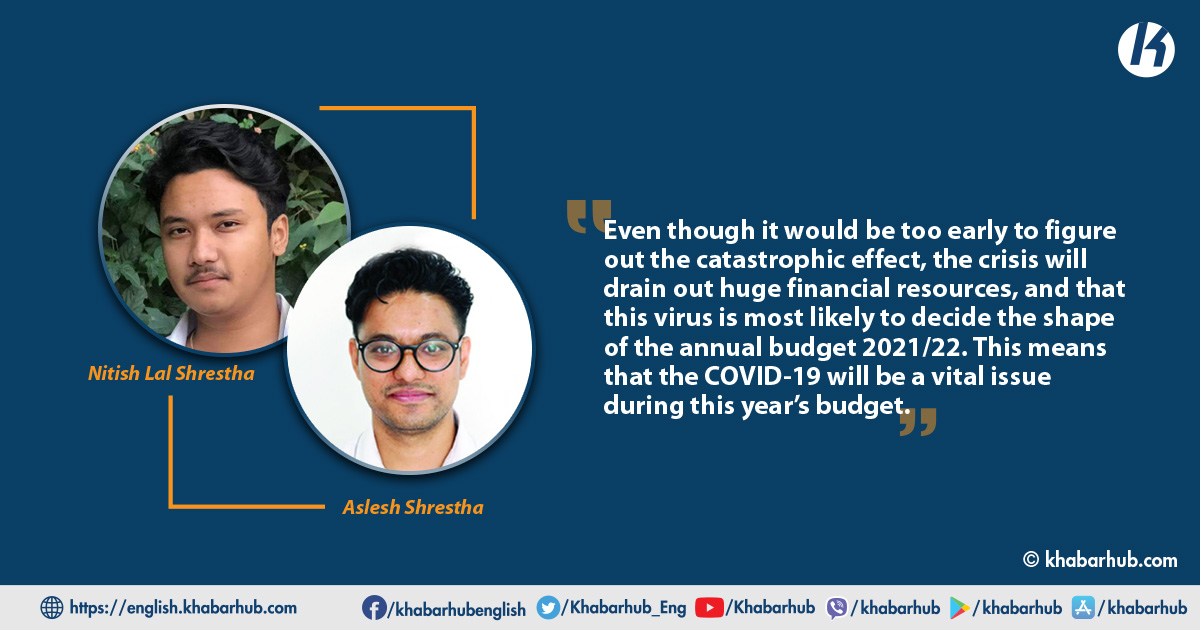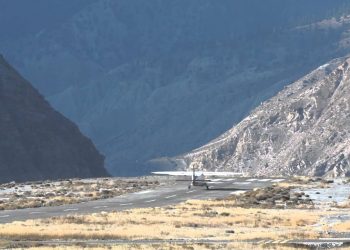As the COVID-19 pandemic wreaks havoc around the world, Nepal is no exception. The threat to people’s health, disruption to daily life, and damage to the national economy is jarring as Nepal struggles to contain the coronavirus.
In this regard, the budget will play a crucial role in the government’s response to this virus.
The spread of coronavirus has already had a high impact in the country. As the public health systems are struggling to cope, the costs are sure to increase as uncertainty about the economic impact of the pandemic remains high.
Even though it would be too early to figure out the catastrophic effect, the crisis will drain out huge financial resources, and that this virus is most likely to decide the shape of the annual budget 2021/22. This means that the COVID-19 will be a vital issue during this year’s budget.
Nepal has seen a surge in COVID cases in the last couple of weeks. With coronavirus cases increasing in India, there is a fear among both the citizens and policymakers here that the situation could get out of control if not dealt with extreme caution.
Past budget trends have shown that a larger proportion of government expenditure has been spent on current expenditure.
The impact of the virus with a new variant will make the case in Nepal more severe largely because of the open and porous border between Nepal and India.
The government has enforced a lockdown to restrict unnecessary public movement while continuing to allow only essential market activities.
This has certainly posed an additional threat in balancing between human life and livelihood in the forthcoming budget of the FY 2078/79.
For the first time after four decades, Nepal experienced negative growth of 1.9 percent. After the impact of COVID-19 was lessened the human casualties were less and there was a slow recovery of the economy except for the tourism sector.
Currently, the political uncertainty and poor management of the health services system have complicated the prioritization and resource allocation in the forthcoming budget.
The budget for FY 2077/78 is the 4th budget of the current government and the 2nd budget since we entered the Covid-19 era.
Without undermining the significance of any previous budget, the fiscal year budget for 2077/78 was crucial because it would lay the foundation for economic recovery in the COVID-19 era, as the last quarter of the previous fiscal year was spent in complete lockdown, which had adverse implications for the Nepalese economy.
The 2077/78 budget was downsized in comparison to the previous FY which was expected because of restricted economic activity during the lockdown which had impacted the government’s main revenue source i.e. taxes.
The current situation is more severe because of declining revenue and increased expenditure. The result is sustaining the economy, as the major source of funding becomes external assistance for deficit financing.
It indicates the dependency on external soft loans will be much higher in the future.
The government spent resources on economic relief programs (which was not practical), purchasing vaccines, and other medical expenses.
The additional cost in the economy was the main protagonist to increase public debt at 46.7 percent of the GDP.
The fiscal deficit constitutes 8 percent of the GDP against 5.8 percent during the year 2020. The priority of the current budget becomes more challenging because increasing capital expenditure in infrastructure by harnessing private and foreign investment is not very easy.
So, the priority of the next budget is managing and balancing between short-term relief measures and medium-term economic recovery.
In our last FY 2077/78 budget the government allocated resources at the cost of other equally important priority projects.
As large amounts are frozen in the accounts of various government ministries, the banking sector tends to face a liquidity crunch at some point during the FY.
They should make sure, at least the national priority projects which are at the final stage to be completed should not experience budgetary constraint so that we may not again experience time and cost over-run.
Past budget trends have shown that a larger proportion of government expenditure has been spent on current expenditure.
Even then the successive governments have failed to spend the portion allotted for capital expenditure. Identified bottlenecks that restrict the government’s capability to spend on capital expenses are corruption, bureaucratic red-tapism, and an incompetent workforce.
The Office of Auditor General estimates the arrears constitute half of the annual budget. It costs approximately Rs. 322 billion of the GDP.
Rife corruption and rent-seeking tendencies in government projects and procurement processes dissuade global firms to enter into government projects.
Incompetent workforce and the red-tapism within the government further discourage firms that are willing to invest in these projects.
Lack of ambitious projects means that large portions are unspent until the last quarter of the FY and then the annual phenomenon of “Asare Bikas” occurs as the government hastily spends on existing infrastructure.
The informal labor workforce’s inability to spend is also prohibiting them from providing employment. Even if such infrastructure projects are scheduled and implemented on schedule, a shortage of qualified engineers, architects, and laborers results in substandard infrastructure.
Lack of spending or the slow pace at which the government spends the budget creates problems for the banking sector.
Health spending needs to be continued and in fact, increased to create better health infrastructure to increase the preparedness of the health sector for future crises.
As large amounts are frozen in the accounts of various government ministries, the banking sector tends to face a liquidity crunch at some point during the FY.
This liquidity crunch is exacerbated after the festive season as consumer spending increases sharply further reducing the loanable funds available with the banks.
Adding to these issues, the government also has a habit of relying on aid for development expenditure even when it is consistently failing to spend its budget expenses timely and effectively.
After the 2015 earthquake, the governments have stooped lower as they expect countries to take initiative and complete the reconstruction projects on their own.
Recommendations for the upcoming budget
Like most of the economies continue the move towards recovery and ever slowly towards economic growth in the current FY, Nepal’s recovery is no different.
But a stumbling block for the Nepalese economy is that the 2nd wave of the Coronavirus seems to have arrived with daily cases of over 8000 in the past few days.
Continuation of the COVID crisis means that the estimates for the growth rate of this FY might have to be adjusted again.
Since the coronavirus has affected the income sources of citizens on the lower end of the income scale, the government should boost social security expenditure in the forthcoming budget, or at the very least retain the current year’s social spending budget for the next fiscal year.
It is necessary that employees transition systematically and effectively to the provincial and local levels as the government at these levels is already struggling due to a lack of quantity and quality in their workforce.
Health spending needs to be continued and in fact, increased to create better health infrastructure to increase the preparedness of the health sector for future crises.
The government must not treat Covid-19’s second wave as if it is the last. The fight against Covid-19 will take some time for the world to win.
As a result, the new budget must prioritize health infrastructure investment over other areas that can wait.
To address the unemployment crisis, more budget and productive programs are required, especially in the informal sector.
Similarly, MSMEs continue to struggle to produce enough revenue to maintain their economic operation, and they will look to the government for additional assistance beyond soft loans.
Tax exemptions for MSMEs on machine purchases should be addressed by the government.
Subsidies, tax provisions to new agro-industries and local manufacturing to make it competitive against imports (rather than increasing import taxes).
The agriculture sector needs to continuingly receive the financial support it has been receiving as even in the pandemic situation it is expected to perform well and contribute strongly to the GDP in the current FY.
Measures to correct the inability to spend the capital expenditure budget need to be taken.
Government can establish an independent body/board to handle infrastructure spending to increase the efficiency and transparency of government infrastructure projects.
The government also should look into exploring new avenues or strengthening the current sources for increasing non-tax revenue.
One major issue the government needs to address is the ruckus created by employee adjustment from federal to provincial and local levels.
It is necessary that employees transition systematically and effectively to the provincial and local levels as the government at these levels is already struggling due to a lack of quantity and quality in their workforce.
If not dealt with, this will only add to the existing incompetence in the public sector.
The budget trends suggest that the whole of the government’s revenue is usually spent on current expenditure which shows that the government needs to start acting out to reduce the recurring expenses.
The government should start the process of digitization of certain public services to start with as that can reduce some of the operating costs.
Apart from the rising current expenses, the Constituency Development Fund, for which over Rs. 6.6 billion was allotted in the current budget, has had its share of critics due to lack of transparency and usually spent on people-pleasing rather than for the development of the constituency.
As for increasing tax revenue, tax collection can be incentivized but more importantly, the government needs to focus on widening the tax base.
Usually, governments increase the tax rates to increase revenue and this discourages economic activity and/or encourages tax evasion.
One way to increase the tax base can be the creation of a new tourist infrastructure. This would not only employ locals in the construction process but also will provide locals with business opportunities in and around tourist spots.
The government also should look into exploring new avenues or strengthening the current sources for increasing non-tax revenue.
In the previous fiscal year’s budget, the government failed to provide effective relief packages for those affected by the economic impact of Covid-19.
Spending needs to be increased to build new tourism infrastructure, from which additional revenue can be generated, and maintain the current tourist spots for sustained revenue. Increased tourist activities would lead to increased revenue from royalties as well.
For the tourism sector projects, the government can encourage Public-Private Partnerships (or revenue sharing model).
Positive experiences in the hydropower sector and forest management projects have shown that revenue sharing partnerships work well; this can be the way forward for generating additional non-tax revenue.
Apart from this, the digitalization of payment systems for fees, fines, and penalties can lead to a quicker collection of revenue.
In the previous fiscal year’s budget, the government failed to provide effective relief packages for those affected by the economic impact of Covid-19.
However, it is high time for the government to take measures to resolve the issue. Apart from the health impact of Covid-19, the economic impact is also important, and entrepreneurs are finding it tough to escape.
The government has to keep the economy running and provide relief to these entrepreneurs. Let’s hope that the upcoming budget will not be as poor as the previous one, and that people will see a return on their taxes this time.









Comment